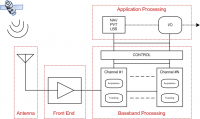If you wish to contribute or participate in the discussions about articles you are invited to contact the Editor
System Design Details: Difference between revisions
Jump to navigation
Jump to search
Rui.Sarnadas (talk | contribs) No edit summary |
Rui.Sarnadas (talk | contribs) No edit summary |
||
| Line 8: | Line 8: | ||
}} | }} | ||
In order to process the [[GNSS signal|L-band signals]] transmitted from the satellites and compute the navigation solution, a GNSS receiver | In order to process the [[GNSS signal|L-band signals]] transmitted from the satellites and compute the navigation solution, a GNSS receiver can be designed to target different applications, markets, and solutions. From single or multi-frequency, single or multi-constellation, to survey or automotive applications, system specification details extend through a broad range of decisions and trade-offs, in order to achiev e the best performance desired. The folowing sections tackle some considerations at a GNSS receiver system design level. | ||
==Overview== | |||
The basic structure shown in Figure 1. | The basic structure shown in Figure 1. | ||
Revision as of 12:02, 5 April 2011
| Receivers | |
|---|---|
| Title | System Design Details |
| Author(s) | GMV |
| Level | Medium |
| Year of Publication | 2011 |
In order to process the L-band signals transmitted from the satellites and compute the navigation solution, a GNSS receiver can be designed to target different applications, markets, and solutions. From single or multi-frequency, single or multi-constellation, to survey or automotive applications, system specification details extend through a broad range of decisions and trade-offs, in order to achiev e the best performance desired. The folowing sections tackle some considerations at a GNSS receiver system design level.
Overview
The basic structure shown in Figure 1.
Block diagram


